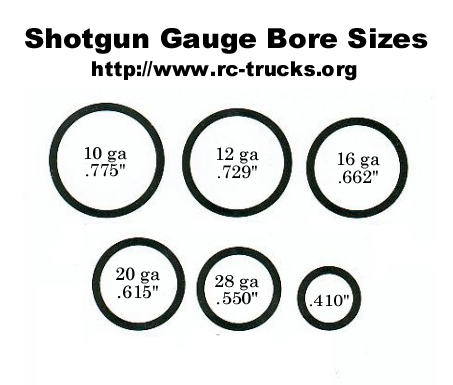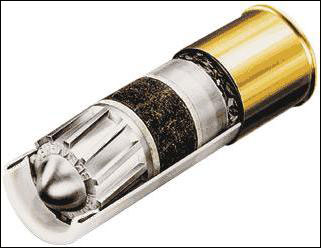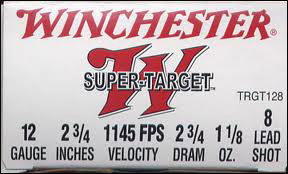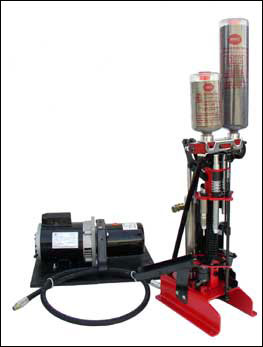Shotgun Shells
About Shotgun Shells
The components of a shotgun shell include the rim, primer, brass, shell case, powder, wad and shot — with the exception of shotgun slugs, which are like blunt bullets encased in a shotgun shell and used on larger game.
When you pull the trigger on your shotgun, the firing pin in the gun strikes the primer of a shotgun shell, igniting the powder that emits a gas as it burns. The gas creates enough pressure to propel the wad-containing shot hard and fast enough to decimate the target. As the wad and shot leave the muzzle, you can see the wad fall away like the first stage of a rocket. The shell case, or spent hull, remains fairly intact except for the blown open crimp at the top and the spent primer. Many shotgun enthusiasts use the leftover hull by reloading it with new components.

Gauges
Unlike most firearms that are grouped by calibers, shotguns are categorized by gauges. The gauge of the shotgun dictates the gauge of the ammunition it fires. The main difference is that a caliber is a dimension while gauge represents weight.
The most popular shotgun gauges are 12, 16, 20, 28 and .410. Some vintage shotguns and a few modern semi-auto shotguns specialized for goose hunting come in 10 gauge for significant stopping power. Whereas the U.S. commonly uses the word “gauge,” Great Britain and other countries often use “bore.” They both refer to the same sizes.
Shotguns are measured in gauges because of the type of ammunition they use. While other firearms discharge precision projectiles, shotguns fire a shell that is packed with round, lead BB-like pellets. The pellets spread in a funnel pattern once they leave the muzzle of the shotgun, hence the term “scatter gun.”
Gauge refers to the number of identically sized balls cast from one pound of lead that could fit through a specific barrel diameter. Gauge is a weight measurement and dates back to the origination of cannonballs.
A 12-gauge shotgun would theoretically shoot 12 balls of equal size (1/12th of a pound) cast from a single pound of lead while a smaller 20-gauge shotgun would shoot 20 lead balls that weigh 1/20th of a pound. The exception is .410 — the smallest of shotguns shells — which is considered a bore that is used in a few specialty pistols that also shoot .45 caliber bullets.

When it comes to shotgun bores, the smaller the gauge the bigger the diameter of the barrel. 12 gauge is .729 inch, 16 gauge is .662 inch, 20 gauge is .615 inch and 28 gauge is .550 inch.
In modern shotgun shells, the liquid chemical antimony is added to lead to increase its hardness. Antimony controls pellet distortion after the shot is fired — contributing to more consistently round pellets. Antimony levels range between 2% and 6%.
Shot Pellet Size
The shot number dictates the number of pellets per shell. Not only does the shot number refer to the average pellet count, it stipulates the approximate size of each pellet. The bigger the shotshell number the higher its pellets count.
| Shot Pellet Size Number (lead) | Shot Pellet Diameter in Inches | Approximate Number of Shot Pellets |
|---|---|---|
9 | .08 | 585 |
8½ | .085 | 485 |
8
Advertisement | .09 | 410 |
7½ | .095 | 350 |
6 | .11 | 225 |
5 | .12 | 170 |
4 | .13 | 135 |
2 | .15 | 90 |
BB | .18 | 50 |
The above chart shows the most common shot sizes. It illustrates that you can purchase shotgun shells of different gauges with various size pellets. The shot pellet sizes are not mixed in the shell, but remain uniform.
The larger the shot pellet size, the more of them are packed into the casing. Sizes 9 – 7½ are typically used for the clays sports or small game birds. Anything larger than 7½ is suited for bigger game birds such as pheasants or waterfowl. You want the larger pellets for these birds because you need the extra density to penetrate thick feathers and bones in order strike vital organs for a clean, ethical kill. However, a growing body of environmental legislation is forcing hunters to move away from lead for waterfowl to non-toxic steel and alloys which can have different ballistic properties.
To calculate the approximate number of shot pellets in your shotgun shell, see the shot charge load on the box. For example, most popular 12-gauge shells are available in 1⅛ ounce, 1 ounce and 7/8 ounce loads and you can divide accordingly.
Slugs
Some shotgun shells are loaded with lead slugs instead of shot pellets. A slug is a bullet-like projectile but often rounded at the tip rather than pointed. Slugs are sometimes mandated in populated areas for hunting larger animals such as deer and feral hogs because their stubby shape doesn’t travel as far and fast as many rifle bullets — reducing the risk of long-range accidents. Most slug loads are 12 gauge, although you can find them 20 gauge and even 28 gauge as well. You should check the manufacturer’s specifications on your shotgun to see if it’s designed to safely shoot slugs without damaging the barrel or the choke.
 A 12-gauge Brenneke slug.
A 12-gauge Brenneke slug.
There are four dominant slug types for hunting: Brenneke, Foster, Saboted and Plumbata. The Brenneke slug is solid with fins on the side and a blunt nose. By contrast, the Foster slug is hollow at the rear in order to shift its mass toward the front. Fins on the Foster slug act as stabilizers. Saboted slugs have a lead core with copper jacketing or are manufactured from solid copper with a plastic sabot that gives it ballistic spin like a rifle bullet. The Plumbata slug features a plastic stabilizer that’s attached to either the bottom of the slug or over it.
Shotshell Lengths & Powder Measurements
Shotshells are typically made in two popular lengths: 2¾ and 3 inches (including 3-inch Magnum). You can also find 3½-inch turkey loads. On the other extreme, shotgun shells are made in 2-inch and 2½-inch lengths and are typically used in vintage shotguns.
The chamber of the shotgun (where you load the shell) tells you what length shell is permissible. A shotgun with a 3-inch chamber can accept 2¾ inch shells as well as 3-inch shells, but a 2¾-inch chamber cannot accept 3-inch shells. To find the chamber size on your shotgun, see the fine print stamped on the barrel or read the owner’s manual.
The difference between 2¾ and 3-inch shells is the amount of smokeless gun powder they hold. Obviously, a 3-inch shell holds more gun powder than one that is 2¾ inches. More gun powder equals greater recoil.
High-volume factory shotshells specify the powder load in “drams equivalent.” Again, this is a measurement that harkens back to the invention of ammunition. Today’s shotgun shells use smokeless powder, but “drams equivalent” indicates the shotshell velocity produced with the equivalent amount of black powder once used in the earliest ammunitions. A box of shotgun shells labeled “3 Dram Equivalent” means it possesses the force of 3 drams of black powder.
Reading a Box of Shotgun Shells
The top flap of a shotgun shell box tells you about the ammunition. For safety purposes, you must be certain that the shotshells you purchase are suitable for your gun.

In terms of gauge, do not shoot a smaller gauge shotgun shell in your gun than is required by the manufacturer. For instance, don’t drop a 20-gauge shell into a 12-gauge shotgun. Unless you have a set of sub-gauge tubes that fit into your barrel, ammunition sizes are not interchangeable in shotgun barrels.
On the box, the number above the words “Lead Shot” refers to the shot size. Sizes 9 – 7½ are best for clay target sports. In fact, many shooting clubs prohibit shot sizes bigger than 7½ on a clays course. That’s why you’ll often see boxes of shotgun shells with shot sixes of 7½, 8 and 9 labeled as target loads. Check with your club for shot-size rules and regulations.
Another specification on the box is FPS. This stands for feet per second or velocity. You should assume that the higher the velocity the stronger the recoil and the further the shot will travel.
INCHES refer to the shell length.
OZ. or ounces tells you how much shot is in the shell. There is some correlation between the amount of shot and recoil. A 1-ounce shell will generally shoot lighter than a 1⅛ ounce shell. That said there are some very fast 7/8 ounce game loads with substantial kick. If you are recoil-sensitive, start with a 1-ounce, 12-gauge shell or move down to a 20-gauge or 28-gauge shotgun.
On the lid of the box, DRAM is the smokeless powder equivalent to black powder. The standard in a 12-gauge shotgun is 2¾ dram with a 3-dram equivalent. Anything more will kick harder.
While shopping for shotgun shells it’s important you buy the right load. In addition to safety concerns, many retailers do not allow you to return a box of shells.
Low-Recoil Shotgun Shells
The felt recoil of a shotgun shell can be reduced by simply loading it with a smaller amount of slow-burning, smokeless gun powder. Slow-burning powder helps cut the jolt of higher performance, standard powders; while a smaller amount of it compared with a standard load correlates with a softer kick. Low-recoil shells are also touted to be quieter. The big payoff could be up to a 50-percent reduction in felt recoil.
Shotshell manufacturers that produce low-recoil ammunition include Winchester, Fiocchi, Remington, Rio, RST and Holland & Holland.
Low-recoil shells are generally suitable for clays shooting where the targets are of moderate distance. You may also be able to use them for walk-up hunting where the flushing birds tend to be relatively close to the shooter.
New shooters, who are still struggling with proper gun mounts, can use low-recoil shells to control felt recoil to the shoulder and face. Women coming into the shotgun sports, using a man’s gun, may also turn to low-recoil shells to avoid bruising from the kick of the shotgun. Shooters who develop a flinch may find that low-recoils shells can cure their problem. Low-recoil shells are also preferred by owners of vintage shotguns with aging barrels that pre-date today’s powerful, modern ammunition.
There are some penalties to using low-recoil shells. Compared to standard shotgun shells, you may suffer 10 – 20 percent reduction in velocity. For sports such as skeet or 16-yard trap, the slower shell may not make a difference in your performance. When it comes to challenging 5-stand courses, sporting clays with mixed presentations or handicap trap, low-recoil shells may exact a toll on your scores.
For upland hunting, a 900-FPS, low-recoil load may be effective on dove and quail. What about larger birds such as pheasants? Not recommended, but you may want to try a low-recoil shell with a tight choke to increase density of the shot pattern. Still, you don’t want to cripple birds, and after one or two hits, you may want to reconsider switching to a faster shotshell with perhaps a wider choke for the bigger upland quarry. In this case, if the more powerful shell delivers an uncomfortable level of recoil, consider switching to a 12-gauge semi-automatic shotgun that diverts excess gas from the spent shell into its own operating mechanism. These types of semi-automatic shotguns tend to shoot softer than an over/under. However, if you are bird hunting at a private club, double check their rules because some of them don’t allow semi-automatics.
Price is another potential drawback to low-recoil shells. In some instances, you may pay nearly twice as much for a box of low-recoil loads compared with standard shells at big-box retailers.
You’ll generally find low-recoil loads in 12 gauge and 20 gauge. Smaller shotguns such as 28 gauge and .410 shouldn’t really present a recoil problem with off-the-shelf shells and may in fact be a better alternative for recoil-sensitive shooters.
Steel Shot and Other Non-Toxic Shotshells
Non-toxic shells are becoming more popular as the Environmental Protection Agency and conservation groups move to limit or ban the use of lead ammunition on public hunting grounds. Their argument is that residual lead poisons fish, waterfowl and predators. Likewise, some private hunting clubs are requiring non-toxic shotgun loads.
The most popular non-toxic shotgun loads are packed with pellets made of steel, Tungsten (frequently alloyed with nickel, iron or bronze), Bismuth or some combination of these materials. Non-toxic materials differ in their density, stopping power (energy) and velocity.
Steel decelerates more than other non-toxic shotgun loads and is recommended for close shooting such as decoy hunting. Because of its hardness, steel shot should not be used with full or extra-full chokes for fear of damaging the barrel or choke. Find out if your shotgun barrel is rated for steel shot before making a purchase. Likewise, confirm whether or not your choke is rated for steel.
The hardness of steel also presents problems for bird hunting. Basically, you want a shot material that will flatten and spread when it hits your prey for better stopping power. Steel shot, because of its hardness, can pass through an animal rather than lodge in vital organs for a fatal wound; the results can produce an unwanted number of wounded birds.
In terms of shot density, steel is about 70 percent as dense as lead. Bismuth shot is nearly as dense as lead. Some tungsten alloys come close to the softness and density of lead shot. Hevi-Shot is the heaviest of the non-toxic ammunition. With the exception of 100-percent steel shot, other non-toxics should be effective on longer range, waterfowl, passing shooting.
Because of steel’s relatively low density, hunters will generally increase their shot size compared with other non-toxics and lead in order to compensate for the lower penetrating power and shorter recommended distances.
Get ready for sticker shock, though. You can expect to pay between $15 and $40 for a box of 10 premium non-toxic shotgun shells compared with a low of $6 for a box of 25 shells packed with lead pellets.
Reloading
Most reloading fans will tell you they make their own loads to save money. But the ability to customize your shells for performance and recoil often makes for a more compelling argument to build-your-own.
Reloading your own shotgun shells may indeed cost less than off-the-shelf boxes even at big box stores. The other side of the equation is time and travel. You still need to drive somewhere for 25-pound bags of shot, bulky bags of wads and jugs of powder. Online purchasing is of course an option, but take into account shipping and the cost benefits could easily diminish.
And what about space? Do you have the room for a dedicated reloading bench and assorted accessories? You need to also consider that reloading is dirty. Shot pellets will inevitably spill all over the place. Gunpowder granules spread like dust, except they leave a black residue. And pretty soon the area smells of grease and cleaning solvents.
 A MEC reloading press.
A MEC reloading press.
To start, from a financial perspective, you need to rationalize the initial cost of a shotshell press. Mayville Engineering Co. — fondly called MEC — may be the volume leader in the industry. You can purchase an entry-level MEC press for under $200 then move up to a fully tricked-out version for a price approaching $1,200. Posness/Warren reloading presses can cost from $700 to $1,000.
For 12-gauge shells, you may find the balance sheet tipped in favor of low-cost shells from big-box retailers. The same financials may apply to 20-gauge shells — except when you get into competition loads packed with number 8 or 9 pellets. Moving to 16 gauge, 28 gauge and .410, the smart money is typically on reloading over store-bought.
For 12 and 20 gauge, however, it would be tough to sustain a strong financial case for hand-loading versus retail — unless you talk about quality.
It all begins with the Lyman Shotshell Reloading Handbook or something similar. Individual components such as hulls, wads, powders and primers have distinctive ballistic characteristics. Manuals such as Lyman’s provide “recipes” for nearly every type of requirement from soft shooting to blazing high performance. Tweaking the recipes is of course flirting with disaster (remember, shotshells are explosives), but what you will find with sufficient experimentation of different recipes is the perfect load for you — a personalized shell that performs well with the forcing cones of your barrels, your favorite chokes, the particular sport you shoot, your recoil tolerances and the best possible velocity (not necessarily the fastest). In a word, you want consistency rather than the mass-produced shells that could be slightly different from each other as they come off the assembly lines.
If you want to reload, safety is a top priority. Wear shooting glasses, latex gloves and even an apron to prevent contaminants from spreading throughout your house. Keep your area clean; vacuum it whenever necessary. Pay attention: too many shotgun barrels explode with catastrophic consequences after a reloading press accidentally drops a double load of powder into a hull without you noticing it. Don’t be a cheapskate by knocking a live primer out of a discarded hull — or other such nonsense.
Be safe, be smart and always respect the components you are working with, and you can experience many years of fun, and savings that come with reloading your own shot shells. If you aren’t sure where to start, just ask one of us old timers, we are happy to share our knowledge and experience.
Until next time, shoot safe and shoot straight!
Ducks | BB, 1, | Modified–for pass shooting | Use BB shot for long range and pass shooting. For normal range–No. 1 or No. 2 shot while some hunters use No. 3 shot for closer range shooting over decoys. |
Geese | T, BBB, | Modified | Goose hunters need wallop so they use the big loads with large shot. Many hunters prefer No. 1 shot for a denser pattern at shorter ranges over decoys. |
Pheasants | 5, 6, 7½ | Improved Cylinder–for close cover | For cornfield shooting where long shots are usual – better use No. 5. On a normal rise over dogs and for all around use, No. 6 is the favorite. |
Grouse or Partridge | 5, 6, | Improved Cylinder or Modified–for brush work | On the smaller birds such as ruffed grouse or Hungarian Partridge, use the smaller shot. The big western grouse (sage, sooty, and blue) call for heavier loads and larger shot. |
Quail | 7½, 8, 9 | Cylinder | For early season shooting on bobwhites when feathers are light, some hunters use No. 9 shot. Later they switch to No. 7½ or 8. On the running or wild flushing type of quail, such as the Gambel’s, large shot is sometimes used. |
Doves and Pigeons | 6, 7½, | Modified | Use lighter loads and No. 7½ or No. 8 shot on mourning doves at normal ranges –for longer ranges use the heavy loads and No. 6 or No. 7½. Use the same load on band tailed pigeons and white wings. |
Woodcock | 7½, 8, 9 | Improved Cylinder | The choice of shot size here will depend on ranges at which the game is shot. For fast shooting in the alder thickets, No. 8 shot is a good choice. |
Turkey | BB*, 2*, 4, *check local game laws | Full | Choice of shot size depends on the range. If you’re a good caller, No. 6 or No. 7½ shots makes a clean kill. BBs, No. 2s, 4s, 5s, are best for long shots. |
Trap | 7½, 8 | Full or Modified | In most cases, No. 7½ is used for trap. Check the Official Rulebook. |
Skeet | 8, 9 | Skeet Choke | In most cases, No. 9 is used for skeet, check the Official Rulebook. |
Sporting Clays | 7½, 8, 9 | Any choke (Depends on practice desired) | For targets at close range use a more open choke, at longer distances tighten the chokes. |
*Source: Benelli Ammunition and Choke Suggestions

Irwin Greenstein is Publisher of Shotgun Life. Please send your comments to letters@shotgunlife.com.


Comments